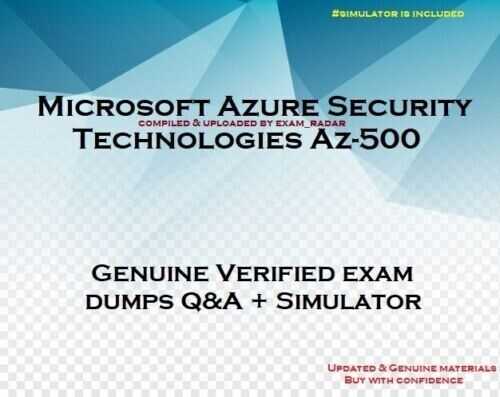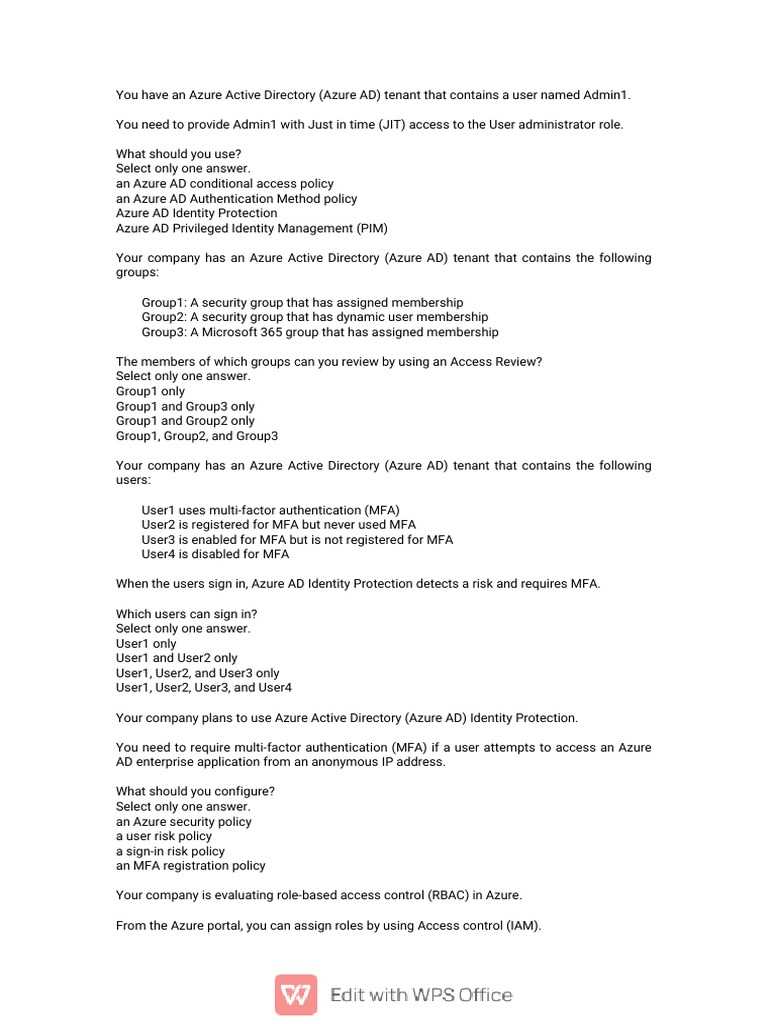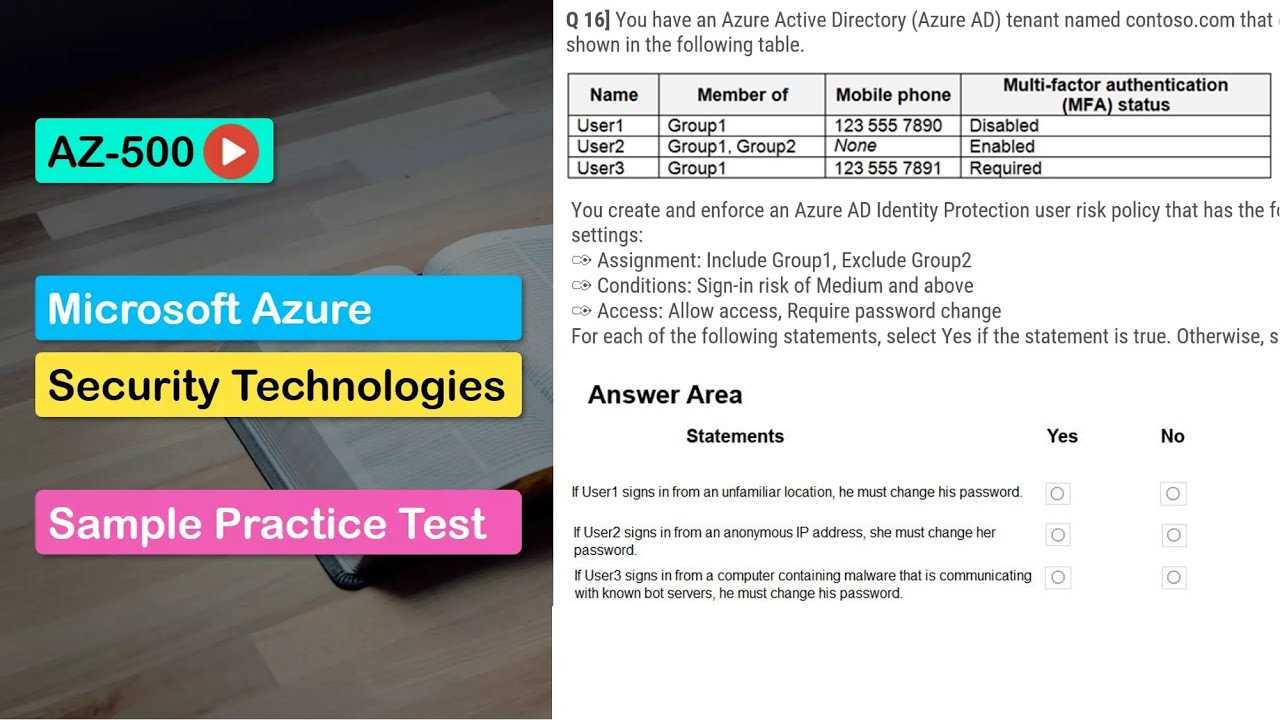
Achieving proficiency in cloud security is a critical skill in today’s IT landscape. To validate your expertise, it’s essential to engage in targeted preparation that focuses on core concepts, practical applications, and problem-solving techniques. The path to certification in Azure security involves understanding key topics and refining your approach to complex scenarios.
Preparation requires not only familiarity with theoretical principles but also hands-on experience with the platform. By practicing real-world tasks and reviewing sample scenarios, you can develop a deeper understanding of security frameworks, threat management, and system configurations.
Building a solid foundation is key to succeeding in this field. Focus on the most relevant areas, and equip yourself with the tools and strategies necessary to demonstrate your capabilities in a formal assessment. Success depends on both the depth of knowledge and the ability to apply that knowledge effectively in simulated situations.
Az-500 Exam Overview and Importance

Achieving a professional certification in cloud security demonstrates a high level of expertise in managing and protecting resources on Azure. This process evaluates your understanding of security solutions, network security, identity management, and threat protection. It is an essential step for those pursuing careers as cloud security engineers or IT professionals focusing on Microsoft technologies.
Importance lies in the credibility the certification provides. It not only validates your technical skills but also enhances career opportunities, opening doors to advanced roles in cloud security. By passing the assessment, you prove your ability to handle complex tasks related to system security, risk management, and compliance within a cloud environment.
The certification is highly regarded in the industry, making it a valuable asset for individuals aiming to advance their careers. Professionals who hold this certification are recognized for their capability to implement best practices, troubleshoot security challenges, and manage security policies within an Azure infrastructure. This recognition is pivotal for both personal growth and organizational trust.
What to Expect from the Az-500 Exam
When preparing for a certification in Azure security, it’s crucial to understand what the assessment entails. The process is designed to evaluate your proficiency in managing and securing cloud-based environments. It consists of a combination of practical tasks and theoretical knowledge that will test your ability to handle various scenarios related to system protection, identity management, and compliance.
Here’s an overview of what you can expect:
- Topics Covered: The assessment will focus on key areas such as threat protection, identity management, cloud security solutions, and incident response.
- Format: The test will include multiple-choice questions, case studies, and real-world simulations where you’ll need to apply your skills in practical situations.
- Time Limit: You will have a set amount of time to complete the entire evaluation, requiring efficient time management.
- Difficulty Level: The content is challenging and designed to assess your understanding of Azure security at an advanced level.
By anticipating these elements, you can better prepare for the challenges ahead and approach the certification with confidence. Practicing with sample scenarios and reviewing critical concepts will help you perform at your best during the assessment.
Key Topics Covered in Az-500
To successfully complete the certification focused on Azure security, it is essential to understand the core areas that are evaluated. The assessment encompasses various aspects of cloud infrastructure protection, risk management, identity solutions, and secure network configurations. A deep understanding of these topics is necessary to demonstrate your competence in securing Azure environments effectively.
Some of the most important subjects include:
- Identity and Access Management: This area covers the implementation and management of user identities, authentication methods, role-based access control (RBAC), and security policies within Azure.
- Platform Protection: Understanding how to safeguard Azure resources through network security groups, firewalls, and monitoring tools is a critical part of the certification.
- Security Operations: This topic involves managing security operations, analyzing security incidents, and utilizing Azure’s security tools to protect resources from threats.
- Data Protection: You’ll need to know how to secure data both at rest and in transit, using encryption, backup strategies, and compliance solutions.
- Governance, Risk, and Compliance: It is essential to understand Azure policies, security compliance requirements, auditing, and managing risks effectively across the cloud environment.
Each of these areas plays a vital role in securing Azure infrastructure, and mastering them will provide the foundation needed to succeed in the certification process. Thorough preparation in these key areas will ensure that you are well-equipped to manage and protect cloud environments at an advanced level.
Preparing for Azure Security Challenges

Successfully securing cloud environments requires a deep understanding of potential vulnerabilities and the tools available to address them. As the adoption of cloud platforms grows, so do the complexities of managing security. Preparation is key to navigating the challenges posed by cloud infrastructure, where proactive risk management and effective response strategies are essential.
Key Areas to Focus On
- Threat Detection: Familiarize yourself with Azure’s built-in threat detection tools like Azure Security Center, which helps identify and respond to security threats across the platform.
- Access Management: Ensure a clear understanding of how to configure role-based access control (RBAC) and manage identity solutions, including Azure Active Directory and multi-factor authentication (MFA).
- Network Protection: Learn how to implement network security best practices, such as using firewalls, network security groups, and virtual networks to isolate and secure critical resources.
- Data Encryption: Master how to secure sensitive data using encryption techniques both in transit and at rest, ensuring compliance with regulatory standards.
Strategies for Effective Preparation
- Hands-on Practice: Engage in real-world simulations and use sandbox environments to get hands-on experience with the tools and features you’ll be working with.
- Study Resources: Take advantage of official documentation, online courses, and practice exams to reinforce your knowledge and become familiar with the format of practical tasks.
- Stay Updated: Cloud security is constantly evolving. Keep up with the latest trends, threats, and solutions in Azure security through blogs, webinars, and community forums.
By focusing on these areas and adopting a proactive approach to security, you will be better equipped to handle the challenges and successfully safeguard cloud resources. Effective preparation not only enhances your skills but also boosts your confidence when addressing real-world security concerns in Azure environments.
Exam Format and Question Types

The assessment designed to validate your Azure security skills follows a structured format to evaluate both theoretical knowledge and practical abilities. It is important to familiarize yourself with the types of tasks you will face and how they are structured, as understanding the format can significantly improve your performance. The process combines different types of questions to measure your competence in various areas related to securing cloud environments.
The test typically includes a mix of the following question types:
- Multiple Choice: These questions provide several possible answers, and you must choose the most accurate option based on your understanding of Azure security concepts.
- Case Studies: You will be presented with real-world scenarios that require applying your knowledge to solve security challenges. These may involve analyzing a problem and selecting the best solution.
- Drag-and-Drop: In this format, you’ll be asked to match items or arrange steps in the correct order, helping to assess your ability to organize and implement security strategies effectively.
- Hot Area: These questions allow you to click or select specific areas on a diagram or interface, testing your practical knowledge of navigating Azure environments and security configurations.
Each of these formats is designed to assess different aspects of your expertise, from theoretical understanding to hands-on problem-solving. Preparation should focus on mastering these formats to ensure a smooth experience during the actual evaluation.
How to Approach Az-500 Questions
When tackling the assessment, it’s crucial to have a strategic approach to ensure you address each task effectively. The key to success lies in both understanding the material deeply and knowing how to interpret and respond to each scenario. Developing a methodical strategy will help you stay focused and avoid common pitfalls that could affect your performance.
Read Each Scenario Carefully
Before diving into an answer, take the time to fully understand the scenario presented. Ensure you grasp the context and requirements before selecting an option. It’s easy to misinterpret questions, especially in case study formats, so careful reading is essential.
Eliminate Obvious Incorrect Answers

For multiple-choice questions, start by eliminating any clearly incorrect options. This narrows down your choices and increases your chances of selecting the correct answer. Focus on the details mentioned in the question to guide your decision-making process.
Time Management is also important. Don’t spend too much time on a single question. If unsure, move on and come back later to review your response if time allows.
By staying organized, reading each task thoroughly, and managing your time wisely, you will enhance your ability to make the right decisions during the evaluation process. Practice with sample scenarios to build your confidence and speed. This approach will allow you to perform at your best and maximize your chances of success.
Study Materials for Az-500 Success
To succeed in a certification focused on Azure security, it is important to use a variety of study resources to strengthen both theoretical knowledge and hands-on skills. Proper preparation requires access to high-quality materials that cover the core concepts and provide practical insights into cloud security management. The right resources will help you not only understand Azure’s security features but also apply them effectively in real-world scenarios.
Key study materials include:
- Official Documentation: Microsoft’s official documentation is one of the most reliable sources for in-depth knowledge of Azure’s security tools and services. It provides comprehensive information on configurations, policies, and best practices.
- Online Courses: Many platforms offer specialized training for Azure security certifications. These courses often include video lessons, hands-on labs, and practice exams that help reinforce your understanding.
- Books: Books specifically designed for cloud security exams offer structured learning. Look for titles that cover Azure security services, threat management, identity solutions, and data protection.
- Practice Tests: Taking mock tests or practice scenarios is crucial. These simulations help you familiarize yourself with the question format and time constraints, improving your speed and accuracy.
- Community Forums: Participating in forums and discussion groups allows you to exchange knowledge and experience with other candidates. Learning from others’ questions and solutions can deepen your understanding.
By combining these study materials, you will develop a solid foundation in cloud security principles, prepare for different question formats, and increase your chances of success. Stay consistent in your preparation and take the time to practice regularly for the best results.
Top Resources for Azure Security Exam

When preparing for a certification that focuses on securing cloud environments, having access to the best resources is crucial for success. These materials should cover a range of topics, from theoretical concepts to hands-on practice, to ensure that you are well-prepared to handle real-world scenarios. Using a mix of official content, training platforms, and community-driven resources will give you a comprehensive understanding of Azure’s security features and best practices.
Official Microsoft Resources

Microsoft provides a wealth of official study materials that are essential for in-depth preparation. Key resources include:
- Microsoft Learn: This platform offers free, interactive learning modules that cover core Azure security concepts and tools.
- Azure Documentation: The official Azure documentation is a comprehensive resource detailing every aspect of Azure security services, from identity management to data protection strategies.
- Microsoft Whitepapers: Detailed guides and technical papers from Microsoft can provide valuable insights into best practices, security frameworks, and compliance strategies.
Training Courses and Platforms
Enrolling in online courses can provide structured learning and hands-on labs to build your skills. Some recommended platforms include:
- Pluralsight: Known for its high-quality courses, Pluralsight offers in-depth Azure security training with practical labs and assessments.
- Udemy: A range of courses specifically designed for Azure security certifications, featuring video lectures and practice exams.
- LinkedIn Learning: This platform provides courses tailored to Azure security, with the added benefit of integration into your LinkedIn profile.
By combining these top resources, you can ensure a well-rounded preparation experience, covering both theory and practical knowledge required for mastering Azure security concepts. Make sure to balance your study routine with hands-on labs and real-world scenarios to reinforce your understanding and boost your confidence.
Time Management Tips for Az-500
Effective time management is a critical factor when preparing for a certification focused on cloud security. With a limited amount of time to complete tasks, it’s essential to be strategic about how you allocate your attention to different sections. Proper planning, knowing when to move on from difficult sections, and pacing yourself throughout the process can greatly improve your performance and ensure you have enough time to review your responses.
Below are some time management tips to help you make the most of your preparation and stay on track during the assessment:
| Tip | Description |
|---|---|
| Practice with Timed Simulations | Simulate the real experience by taking practice tests under timed conditions. This will help you become familiar with pacing yourself and managing time constraints. |
| Prioritize Easier Tasks | Start with questions you find easier to answer. This will build your confidence and ensure you cover simpler sections before diving into more challenging ones. |
| Set Time Limits for Each Section | Break the assessment into smaller sections and allocate a set amount of time for each. Sticking to your time limits will help prevent you from spending too long on any one part. |
| Don’t Get Stuck | If you encounter a difficult task, don’t get bogged down. Move on to the next section and return to the tricky question later if time permits. |
| Leave Time for Review | Reserve at least 10-15 minutes at the end to review your answers. This gives you a chance to correct any mistakes or reconsider answers you may be unsure about. |
By following these time management strategies, you’ll be able to stay focused, avoid rushing, and complete the assessment within the allotted time. Practicing these tips beforehand can greatly enhance your readiness and help you approach the task with confidence.
Effective Study Techniques for the Exam

Preparing for a certification focused on cloud security requires a disciplined approach and the right techniques to retain complex information. A well-structured study plan, combined with active learning methods, will ensure that you grasp both the theoretical concepts and practical applications. Using a variety of study methods will enhance your understanding and improve your ability to recall information when needed.
Here are some highly effective study techniques to help you succeed:
- Active Recall: Instead of passively reading through material, actively quiz yourself on the concepts. This technique forces your brain to retrieve information, improving retention.
- Spaced Repetition: Use spaced repetition tools or apps to regularly revisit key topics. Reviewing material at increasing intervals helps transfer knowledge into long-term memory.
- Hands-On Practice: Set up a practice environment using Azure’s free or trial services. Experimenting with security configurations, identity management, and data protection tools will solidify your understanding.
- Focus on Weak Areas: Identify your weak points and dedicate more time to studying those areas. Concentrate on understanding concepts that are difficult or unfamiliar, as these will be more challenging during the real test.
- Group Study: Study with peers or join online study groups. Engaging in discussions and explaining concepts to others helps reinforce your own knowledge.
- Mind Mapping: Create mind maps to visualize the relationships between different security topics. This can help you see the bigger picture and understand how different concepts interconnect.
By combining these techniques and staying consistent with your study schedule, you’ll be better prepared for the challenges ahead. The key is to be proactive in your approach, stay organized, and ensure that you cover all areas required for the certification.
Common Mistakes to Avoid in Az-500

When preparing for a certification focused on cloud security, it’s easy to make mistakes that can negatively affect your performance. Being aware of common pitfalls can help you approach your study sessions and the assessment with a clear strategy. Avoiding these mistakes will not only boost your confidence but also ensure that you maximize your chances of success.
Here are some common errors to avoid during your preparation:
| Mistake | How to Avoid |
|---|---|
| Relying Too Much on One Resource | Use a variety of study materials such as online courses, books, and hands-on practice to ensure a well-rounded understanding of the topics. |
| Ignoring Hands-On Practice | Simply reading about concepts is not enough. Make sure to practice with real cloud environments to apply what you’ve learned. |
| Overlooking Key Areas | Prioritize all areas of the certification objectives and avoid neglecting topics that seem less challenging. |
| Not Managing Time Effectively | Plan your study schedule and time allocation to cover all topics thoroughly, ensuring you leave time for review and practice. |
| Skipping Practice Tests | Take regular practice tests to get a feel for the format and to identify areas for improvement before the real challenge. |
| Panicking During the Test | Stay calm and manage your stress. Remember to follow time management strategies and avoid rushing through the tasks. |
By recognizing and addressing these mistakes, you’ll be better prepared to navigate the challenges ahead and increase your chances of success. Taking the time to refine your approach will make a significant difference in your performance and confidence.
How to Improve Your Answer Accuracy
To excel in a certification focused on cloud security, it’s crucial to improve your ability to provide accurate responses under pressure. Developing this skill requires a combination of effective study habits, strategic preparation, and the application of critical thinking during the actual assessment. By refining your approach, you can significantly enhance your accuracy when tackling complex scenarios.
Here are some key strategies to help you improve the accuracy of your responses:
- Understand the Core Concepts: Rather than memorizing facts, aim to fully grasp the underlying principles of each topic. This deeper understanding will enable you to approach questions with confidence and clarity.
- Practice with Real-World Scenarios: Engage in hands-on exercises that simulate real-life cloud security challenges. The more you practice solving actual problems, the better prepared you’ll be to answer similar questions in the future.
- Focus on Keywords: Pay close attention to the language used in questions. Identifying key terms and understanding what the question is specifically asking will guide you toward the correct solution.
- Review Incorrect Responses: After taking practice tests or mock scenarios, carefully review any incorrect responses. Understand why the answer was wrong and learn from your mistakes to prevent repeating them.
- Use Process of Elimination: If you’re unsure about a particular question, eliminate obviously incorrect options first. This can increase your chances of selecting the correct one, even when you’re uncertain.
- Take Your Time: Rushed decisions often lead to mistakes. Manage your time effectively, but don’t hurry through questions. Allow yourself to think critically and select the most accurate response.
By applying these strategies consistently, you’ll improve not only your accuracy but also your overall confidence in tackling challenging scenarios. Accuracy is a skill that can be developed with practice, careful planning, and a focused approach to studying.
Real Az-500 Exam Questions and Answers
When preparing for a certification focused on cloud security, one of the most valuable resources is the opportunity to review real-world scenarios and practice problems. These authentic examples can help you understand the format of the content, the type of challenges you might face, and the level of detail required to succeed. By working through real case studies, you will gain a deeper insight into the subject matter, which is crucial for performing well in the final assessment.
Here are some sample problems that reflect the types of tasks you may encounter:
| Scenario | Solution |
|---|---|
| Configuring Azure Firewall for a Multi-VNet Environment | Ensure proper routing and network security group configurations across VNets. Apply firewall policies and ensure that traffic is properly filtered based on the security requirements. |
| Setting Up Role-Based Access Control (RBAC) for Azure Resources | Define custom roles to match organizational requirements, and assign them appropriately to users, groups, or service principals using Azure’s RBAC system for granular control. |
| Implementing Multi-Factor Authentication (MFA) for Admin Accounts | Configure MFA using Azure Active Directory, and enforce it for high-privileged accounts to enhance security. Implement conditional access policies for additional protection. |
| Securing Data in Azure Blob Storage | Enable encryption at rest and in transit, and configure access policies using Azure Storage firewall and virtual network rules. Implement shared access signatures for temporary access. |
| Designing a High Availability Architecture with Azure Load Balancer | Set up Azure Load Balancer to distribute traffic across multiple virtual machines in different availability zones, ensuring high availability and minimal downtime during failures. |
By practicing with real-world problems like these, you can build the necessary skills and strategies to tackle similar challenges during your certification assessment. This approach will not only boost your confidence but also enhance your problem-solving abilities in a practical, hands-on way.
Sample Practice Questions for Az-500
To effectively prepare for a cloud security certification, practicing with sample scenarios is essential. These practice problems are designed to simulate the types of tasks that one might face during the actual assessment. By working through these examples, individuals can sharpen their knowledge, test their readiness, and improve their problem-solving skills. Here are a few practice situations that represent typical challenges in the field of cloud security:
Scenario 1: Configuring Network Security
In this scenario, you must configure the security settings for a virtual network to ensure data protection and minimize potential vulnerabilities.
| Task | Correct Approach |
|---|---|
| Implement firewall rules for an isolated subnet | Create custom network security group rules and apply them to restrict traffic. Use IP filtering to allow or block specific addresses. |
| Set up VPN to secure communications | Establish a site-to-site VPN connection, configure secure tunnels, and apply encryption for data in transit. |
Scenario 2: Identity and Access Management

This task tests your ability to configure access and permissions for users and resources to ensure security within the cloud environment.
| Task | Correct Approach |
|---|---|
| Assign user roles and permissions for access control | Use role-based access control (RBAC) to assign the least privilege principle, and create custom roles when necessary. |
| Implement Multi-Factor Authentication (MFA) | Enable MFA for all administrator accounts to add an extra layer of security when accessing cloud resources. |
These practice exercises are designed to enhance your understanding of key security concepts. By simulating real-world scenarios, you will gain valuable experience in addressing common challenges faced by professionals in cloud security. Practicing with such scenarios will significantly improve your ability to solve problems effectively when it matters most.
Understanding Exam Scoring and Results
When it comes to evaluating your performance in a certification assessment, understanding how scores are calculated and what the results mean is crucial. The process of scoring involves a combination of correct responses, time management, and the complexity of the tasks. It is important to familiarize yourself with the criteria that determine your outcome, as this knowledge can help guide your preparation and set realistic expectations.
How Scoring Works
The scoring system for a certification test typically takes into account the number of correct responses, the difficulty of the tasks, and the weighting assigned to different sections. Generally, each answer contributes to a cumulative score, and the final result is an aggregate of how well you performed across all the domains.
- Task Weighting: Each topic or section may be weighted differently based on its importance in the overall assessment.
- Time Factor: Completing tasks within the allotted time can also influence your score, as efficiency is often factored into the final evaluation.
- Pass Mark: A minimum threshold score is usually required to pass, and this varies depending on the specific certification.
Interpreting Your Results

Once you receive your results, it’s essential to understand what they represent. A passing score indicates that you have demonstrated sufficient knowledge and skills to meet the requirements of the certification. A non-passing score may provide you with detailed feedback, pointing to areas where further improvement is needed.
- Pass: You have met the standard for certification and demonstrated competency in the required areas.
- Fail: Areas that need more focus and practice are identified. Reviewing the topics where performance was weak will help in future attempts.
By understanding the scoring system and interpreting your results properly, you can approach the process with confidence and clarity, ensuring a more effective preparation strategy for the next opportunity.
How to Interpret Your Score
Understanding the outcome of your certification assessment is key to evaluating your preparedness and identifying areas for further growth. The score you receive not only reflects your overall performance but also provides valuable insights into how well you grasp different topics. Knowing how to interpret these results can help you focus your future study efforts and improve your chances of success.
What the Score Represents

Your score is a direct reflection of how well you performed during the assessment, based on the tasks you completed and your accuracy in addressing various scenarios. In most cases, the score is calculated by counting the number of correct responses and factoring in the difficulty level of each task. It is important to note that different sections may have different weightings.
- Overall Performance: A higher score typically indicates strong proficiency in the subject matter, while a lower score suggests there may be areas requiring more study.
- Weighted Areas: Some topics might contribute more heavily to your final score, depending on their relevance to the certification’s objectives.
Understanding the Feedback
Along with your score, you may receive feedback highlighting areas where you performed well and sections where improvement is needed. This feedback can be instrumental in guiding your preparation for retakes or for other certifications. Here’s how to interpret the feedback:
- Strengths: If you received high marks in specific sections, it indicates a solid understanding of those areas. Use this information to focus on other topics that require more attention.
- Weak Areas: A lower score in particular domains signals areas where more study is needed. Consider reviewing these sections in detail and practicing related tasks.
- Next Steps: Use your score as a roadmap to refine your study plan. Target weaker areas and consider additional practice or resources to improve your skills.
By understanding the meaning behind your score and feedback, you can take a strategic approach to your professional growth and be better prepared for future opportunities.
Post-Assessment Steps and Certification
Once you have completed the assessment, it’s important to understand the next steps in your journey toward certification. The process doesn’t end with simply finishing the test. Instead, the post-assessment phase offers crucial actions that will guide you towards receiving your certification and preparing for future opportunities.
First, take the time to review your performance and evaluate the areas where you excelled, as well as those that may require further attention. This analysis can be instrumental in shaping your next steps, whether that involves additional study, retakes, or exploring further qualifications.
Receiving Your Certification

If you performed successfully, you will receive your certification, which serves as formal recognition of your knowledge and skills in the subject area. This certification can open doors to new professional opportunities and showcase your expertise to employers and colleagues.
- Certificate Issuance: Upon passing the assessment, you will typically receive your digital certificate, which you can download and share with prospective employers or educational institutions.
- Validity and Renewal: Most certifications are valid for a certain period. Keep track of expiration dates and make plans for recertification to stay up-to-date with evolving technologies and industry standards.
What to Do if You Didn’t Pass
Not passing the assessment can feel discouraging, but it’s important to use the experience as a learning opportunity. Review your results, identify the areas where you struggled, and plan your next steps accordingly.
- Analyze the Feedback: Many assessments provide detailed feedback on the areas that need improvement. Use this to focus your study efforts on these specific topics.
- Retake Preparation: Once you feel confident in your knowledge, schedule another attempt. Use additional study materials, practice tests, or training to strengthen your understanding of the subject.
Remember, certification is a process of continuous learning. Whether you pass or need to retake the assessment, each step brings you closer to mastering the required skills and achieving your professional goals.